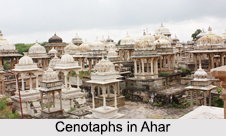 Ahar is 3 kilometers away from the city of Udaipur in Rajasthan. This place is mostly popular for being the cremation ground of the rulers of Mewar. Today, Ahar is also renowned for an archeological museum that offers interesting facts to archaeologists and research scholars. Predominantly, Ahar is famous for the cremation ground and the museum among tourists:
Ahar is 3 kilometers away from the city of Udaipur in Rajasthan. This place is mostly popular for being the cremation ground of the rulers of Mewar. Today, Ahar is also renowned for an archeological museum that offers interesting facts to archaeologists and research scholars. Predominantly, Ahar is famous for the cremation ground and the museum among tourists:
Cenotaphs in Ahar: Cenotaphs in Ahar anticipate the heroism of the rulers of Mewar. In total, there are 19 cenotaphs of the kings, who were cremated there. The cenotaphs have columns, which are raised on big platform sheltered by arched roofs. The architraves of the roofs are ornamented in the style of 15th century temples. On the single upright stone of these architraves, one can find an image of Lord Shiva.
The cenotaph, which is dedicated to Maharana Amar Singh, is the main attraction of the cremation ground. The other cenotaphs are dedicated to Maharana Sangram Singh, Swaroop Singh, Shambhu Singh, Fateh Singh, Bhupal Singh, Bhagwat Singh and Sajjan Singh. These cenotaphs are made out of marble with finest carvings. The cenotaph of Maharaha Sangram Singh is another attraction that has 56 pillars in its porch. It is structured in an octagonal dome in its centre with the support of eight small pillars. He was cremated here in 1734; his 21 wives committed Sati in this very place. These cenotaphs are the proofs that Ahar was an important part in the bygone era. In the late 1990`s, Arvind Singh of Mewar took the initiative to renovate the cenotaphs of his ancestors. This place is a major tourist attraction.
Archeological Museum in Ahar: The Archaeological Museum is another attraction of Ahar among tourists. The items in this museum date back to 10th century, which comprise of iron objects, earthen pots and other artifacts. These were used in the daily lives by the primordial men. Some things even date back to 1700 B.C. A metal figure of Lord Buddha of the 10th century is another attraction of this museum; the statue of Vishnu-Nag-Nathan also deserves a mention.
Many of the items have even been excavated from the mound of Dhulkot. Dhulkot is said to be the site of 4,000 years Old Township. One can see a skin scrubber, grain pot, animal figures, stone weights, balls and seals that date back to the 1st century B.C. Terracotta toys, pottery remnants and a huge earthen pot are the other exhibits of this museum. Above all, the museum portrays some of the best relics of ancient ages.
Visiting Information to Ahar
This place is well connected to all modes of transportation. Udaipur Airport and Rana Pratap Nagar rail station are nearest to this place. It is also connected to bus routes to be reached by car or bus.



















